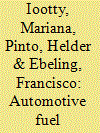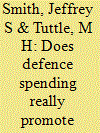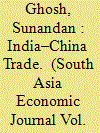| Srl | Item |
| 1 |
ID:
092778


|
|
|
|
|
| Publication |
2009.
|
| Summary/Abstract |
This paper aims to investigate and explain the performance of the Brazilian demand for automotive fuels in the period 1970-2005. It estimates the price and income elasticities for all the available fuels in the automotive sector in the country: gasoline, compressed natural gas (CNG), ethanol and diesel. The analysis of the expenditure allocation process among these fuels is carried out through the estimation of a linear approximation of an Almost Ideal Demand System (AIDS) model. Two estimation methods were implemented: the static (through a seemingly unrelated regression) and a dynamic (through a vector error correction model). Specification tests support the use of the latter. The empirical analysis suggests a high substitutability between gasoline and ethanol; being this relation higher than the one observed between gasoline and CNG. The study shows that gasoline, ethanol and diesel are normal goods, and with the exception of ethanol, they are expenditure elastic. CNG was estimated as an inferior good.
|
|
|
|
|
|
|
|
|
|
|
|
|
|
|
|
| 2 |
ID:
084552


|
|
|
|
|
| Publication |
2008.
|
| Summary/Abstract |
Many studies have examined the relationship between defense spending and growth in real aggregate output with mixed results. Most recently, Atesoglu (2002) finds a positive relationship between defense spending and output. Capturing the error correction term as the long run adjustment parameter and including the long run adjustment in the relationship, we do not find evidence that defense spending promotes growth in real output. Instead, defense spending responds to aggregate income shocks. We re-estimated the relationship and dummied all US military conflicts with similar results concerning military spending's effect on output. Interestingly, we find trade-offs between defense and non-defense government spending during war time.
* The views expressed in this paper are those of the authors and do not necessarily reflect the official policy or position of the US Air Force, the Department of Defense, or the US Government. The authors would like to express their thanks for the comments from Craig Stone and the other participants at the 2006 Canadian Economics Association conference, as well the comments received from three anonymous referees and the editor.
|
|
|
|
|
|
|
|
|
|
|
|
|
|
|
|
| 3 |
ID:
165368


|
|
|
|
|
| Summary/Abstract |
This article seeks to provide an overview of the evolution and analyses the changing composition of trade between India and China over the period 1983–2017. We find that Chinese exports are almost completely concentrated in manufactures, especially finished equipment goods, whereas Indian exports consist of both agriculture and manufactures and over time have shifted predominantly to intermediate goods. Further, both the countries are exporting those commodities to each other in which they have a revealed comparative advantage, with China’s exports being more diversified. We employ vector error correction estimation and show that China’s exports to India are dependent on India’s household consumption expenditure, while India’ exports to China are correlated to Chinese manufacturing value added. Finally, we calculate the share of each country’s commodity-wise export to the partner in their respective total exports with a view to studying prospects for India–China trade. We conclude that for further trade expansion, diversification is extremely necessary, and Indian exports of inputs to Chinese industries need to change substantially to accommodate the changing nature of China’s industrial structure.
|
|
|
|
|
|
|
|
|
|
|
|
|
|
|
|